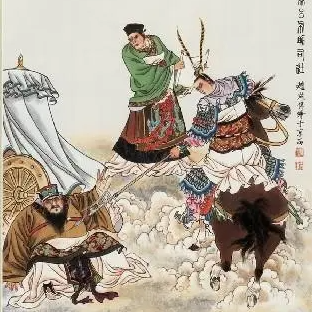buzai overview
 Buzai (pinyin: Bù zāi), also known as cloth, cloth Jane, and cymbals, is a musical instrument of Tibetan and Monba people who strike each other. The Han people call it the big copper cymbal. Popular in Tibet, Sichuan, Gansu, Yunnan and other provinces. Buzai often plays with Jialing, Shengu, Tongqin and other instruments.
Buzai (pinyin: Bù zāi), also known as cloth, cloth Jane, and cymbals, is a musical instrument of Tibetan and Monba people who strike each other. The Han people call it the big copper cymbal. Popular in Tibet, Sichuan, Gansu, Yunnan and other provinces. Buzai often plays with Jialing, Shengu, Tongqin and other instruments.The cymbal surface is large and flat, the diameter of the cymbal surface is 32 cm to 46 cm, the diameter of the bowl is 16 cm to 23 cm, and the height of the bowl is 6 cm to 8 cm. The top of the bowl is drilled and tied with leather rope. a pair.
When playing, hold one side with both hands, wrap the fingers around the top leather rope of the cymbal, hit the right cymbal on top and the left cymbal on the bottom to strike each other, and the sound is loud and heavy. The playing skills are quite distinctive. In addition to frequent mutual strikes, it also shakes the double cymbals to break, the right cymbal tilts down to tap the left cymbal and strikes.
Used in folk songs and dances, Tibetan opera accompaniment and religious music. In the square performance of traditional Tibetan opera, a total of three sets of cloth are used, and one set of different specifications should be selected according to the needs of the plot. Buzai is also an important musical instrument for Tibetan Buddhist monks to chant scriptures and perform religious dances on religious festivals, sometimes using dozens of pairs.
- Pinyin:Bù zāi
- type:Tibetan and Monba people strike each other's body singing musical instruments
- nickname:cloth, cloth Jane, cymbals
overview of other similar instruments
- sanyanxiao overview
- Daguangxian overview
- Leiqin overview
- hahao overview
- yandundagu overview
- Han Xiaozheng overview
- Fang Xiang overview
- guanzi overview
- zhuqin (Dao Qin) overview
- zhuiqin overview
- bangzi overview
- three-stringed piano overview
- Gehu overview
- xiao overview
- xiaokonghou overview
- Konghou overview
- Sheng overview
- suona overview
- hulusi overview
- gushao overview
 渝公网安备 50010702504639号
渝公网安备 50010702504639号